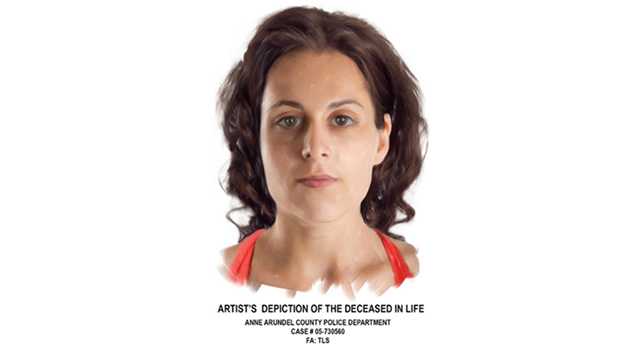http://articles.baltimoresun.com/2011-03-14/news/bs-md-ar-body-20110314_1_remains-dna-old-case
A number, no name, for unidentified Anne Arundel body
Police trying to identify woman found in park in 2005
March 14, 2011|By Andrea F. Siegel, The Baltimore Sun
She has no name. She's known only as 05-730560.
"This is everything we've got," said Anne Arundel County Police Detective John Gajda, plunking down a plastic box that holds folders of what's known about the young woman with reddish brown hair — which isn't much — and her investigation.
Gajda keeps the box at his desk in Crownsville, 17 miles from where children found her decomposing body at the northern tip of the county five and a half years ago.
The woman's remains are kept in the Office of the Chief Medical Examiner in Baltimore. What's left of her mud-caked clothing is packed in a cardboard carton in a police evidence room in Millersville.
Gajda and his cold-case partner, Detective Scott Seegers, are renewing the investigation into the unknown young woman. After looking through files, they found her case and thought they could make progress. They hope to
learn her identity and how she came to be dead under a pink bedspread off a wooded path in Brooklyn Park, not even 100 yards from the city line.
They've got a little more information than police had in the past — full dental information, a broadened description of her, and are waiting for DNA.
Was she a runaway? Why were her shoes off? Did she die of an overdose? Where were her belongings? What of her family?
The early investigation, which included neighborhood canvasses, turned up nothing. The 2007 flier of an FBI clay model and sketch, which depicted a woman with a thin nose and hair just covering her ears, also failed to produce results. An autopsy was inconclusive because of lack of a wound and sufficient tissue.
"It's a mystery," Seegers said.
The case illustrates the challenges police face in trying to lay to rest an old case with nameless, faceless remains and an unknown cause of death. They hope to bring a sense of closure to families and finality to a case. By reopening the case last month, and putting it in the public eye, they hope somebody who knew or recognizes the woman will come forward. Even a nickname would give them a starting point.
Of the 8,000 cases the state medical examiner's office handles annually, hundreds start out as nameless corpses, but most remains are soon identified. For others, dental records and DNA are needed.
"We wind up with about 10 to 12 a year that are not identified," said Dr. David Fowler, the chief medical examiner. A database shows that there are 246 unidentified bodies in Maryland, at least one dating to the Eisenhower Administration.
"By the time we are finished, they are fairly rare, yes. They are still unidentified, which is sad," Fowler said. "This is a human being, this is somebody's friend, somebody's daughter."
His office stores nameless remains while they still have the potential to yield clues, such as DNA.
Then, the remains are sent to the state Anatomy Board, where a month later, and only after officials get a go-ahead from Fowler's office, planning is begun for cremation. The Anatomy Board's schedule for cremation and burial leaves between one and two more years for a family to step forward, said Ronn Wade, director.
The National Missing and Unidentified Persons System, a Department of Justice website, shows 7,328 open cases of unidentified bodies nationwide. And a 2007 report said about 1,000 bodies nationally remain unidentified a year after they are discovered.
Mike Sullivan, program manager for the cold case homicide unit of the Naval Criminal Investigative Unit and a former president of the Mid-Atlantic Cold Case Homicide Investigators Association, said putting a name to human remains is "critical" to any next step in a cold case.
"If you have no determination of a cause or manner of death, that makes it worse," Sullivan said. "You work to try to figure that out."
But it can be difficult. The recent growth of databases — fingerprint, DNA, identifying features — and advances in technology encourages investigators, Sullivan said, but, as the many nameless remains indicate, matches are hard to come by.
Gajda and Seegers are sifting through an inch-thick stack of potential matches to women reported missing nationwide. None of the reports of missing women from Maryland and Washington have panned out, but they're not finished looking through reports from the rest of the country. Still, detectives don't know whether she was ever reported missing by anyone. Fingerprints have yielded nothing.
The investigators are awaiting an FBI profile of mitochondrial DNA extracted from a bone.Once it's available, it can be compared directly to the DNA of someone believed related to the unidentified person. In the FBI's computerized DNA database, it can be compared to the DNA of missing people, convicted offenders and relatives of missing people.
Meanwhile, the detectives plan to add this woman to the department's cold case website. They may present the case at meetings of cold-case investigators and will consider approaching television shows for publicity for the case.









